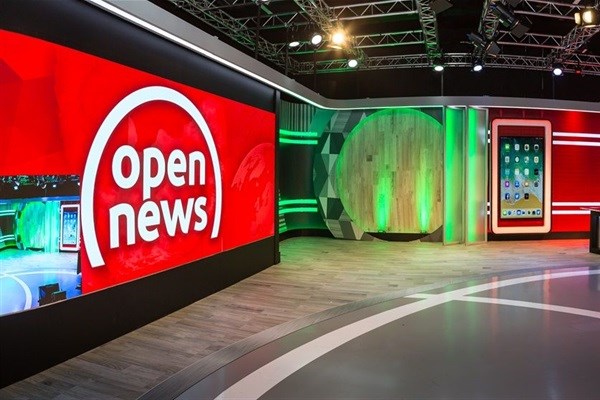How to launch an independent TV news channel like Open News

The morning after the Open News launch, the eMedia studios on Stirling Street are bustling with a quiet hum of productivity. It’s not the frantic chaos you’d expect of a live TV broadcast, largely because they were relishing the success of their first broadcast the night before – and the fact that the vociferous anchors would only be in later that day to prep for their second show.
Allie, now managing director of Open News – formerly Cape Town news editor for eNCA – started me off with a quick tour of the building, where I saw the custom-designed Open News studio just hours after its first live broadcast.
The Open News origin story
Allie explained that Open News operates completely separately from the e.tv team and eNCA. Yet while they have their own flock of video editors, camera people and reporters, they share office space and facilities.
Speaking to the operations specifically, it’s high-class, top-of-the-range infrastructure that wasn’t in use prior to Open News. Two years ago, an executive decision was made to move the Newsday broadcast to Johannesburg – and the other studio, now the Open News home, had never before been used.
Specs for the studios are world-class, and specially built for their vision of the set: They’re HD, with even the floors built within a box to ensure the end result is completely soundproof and straight.
There’s a sports area and video wall rather than a tiny screen, but the social media corner of set is my favourite, where two digital journalists sit over the course of the evening. There’s also a movable table, adding fluidity that keeps things fresh as they’re not always shown sitting behind a desk. These are not “floating heads”, speaking down on their viewers – there’s ample engagement.
More than this, you often see the camera operators and floor manager in shot.
This all adds up to a very different broadcast from everything else you’ll see in the SA media space right now. With the help of some really good set designers, they were able to pull it together in a really short space of time.
Allie says watching it all come to air was phenomenal, as all the hard work they had put in. They also underwent an entire IT system upgrade in September – talk about stress!
It was a lot of hard work, there was even blood, sweat and tears, to get to launch, and about 10 minutes before we went to air, for what felt like the first time since I stepped on this really fast treadmill, I stood outside the studio and was overcome by just how grateful I am to have been at the helm of the process, for having appointed all of these amazing people and for having introduced something to the SA media landscape that people have not seen before.One of the biggest challenges? “It’s not like there are a dozen programme editors waiting around for a job.” A lot of the skills they looked for are skills that are very scarce in this industry, and even scarcer in Cape Town.
In addition, certain things you just can’t train, like attitude and the hunger to want to do this, and being a thinking, conscious citizen.
Allie admits that being part of a launch team is not easy, especially as in this case they were looking for young, talented go-getters – the new age journalist.

And while their sassy anchors are based in Cape Town, they need to speak to and look like the greater South Africa. They feel and have opinions on what people in every single part of the country are thinking and feeling. While the anchors are exposing themselves for the first time in their careers, in a very public, national way, they are aware of that risk.
They’re comfortable with delving into the social media space as well as the traditional space.
Speaking of traditional space, by then we were back at Allie’s office to sit down for a quick-fire Q&A…
 You’re finally live on air! Let’s start with what everyone wants to know: Were there any glitches?
You’re finally live on air! Let’s start with what everyone wants to know: Were there any glitches?
(Laughs). There were many. Every aspect of this launch was challenging. There were many moments when I looked up at the TV screens around me and thought, “They make it look so easy.” It involved everything from the recruitment process, in allowing people to serve notice periods at their previous places of work, to the actual infrastructure and shipping set pieces to South Africa under the tight deadlines, to getting the right graphics in place.
Luckily I’ve been supported by my own management team, and reminded myself that everything that is worth it in life comes with challenge, upheaval and stress. Do I want to launch another channel sometime soon, though? Probably not.
 That’s understandable! Open News is a six-hour evening broadcast, but you also have global news content around that. Explain how that works.
That’s understandable! Open News is a six-hour evening broadcast, but you also have global news content around that. Explain how that works.
We are very conscious of the fact that ours is a new news channel. On the OpenView platform specifically, people had been asking for news and local news at that. But it’s extremely expensive to run a TV operation, and the concept of 24-hour news is a nice to have but would require a lot more resources to not only do that but to do it well.
Bearing that in mind, our local anchors broadcast in the 5pm to 11pm block as that’s the time most South Africans get home from work to consume the news. But we’re also aware that people are consuming news throughout the day as they have access to social media and the internet at their places of work.
It’s proof that viewing patterns are moving so quickly that the need to want to consume large quantities of news is changing. People have shortened attention spans and, because there’s usually a lot of negativity and heaviness in the news, we usually want to know what’s going on and then move on to the next thing.
So we needed a broadcast strategy in which people could both engage with and debate on what’s happened throughout the course of their day, or just get a snapshot of that.
That’s why we have partnered with three international stations – Turkey’s TRT, China’s English-language CGTN, and France24. They offer similar production values to Open News, and offer a variety of programmes that gives an international lifestyle slant.
As much as we have access via social media to things happening in our country, there’s a greater awareness of South Africa being part of a greater world.
The variety brought by our international broadcasters gives our viewers with the best of what both worlds – what SA has to offer, what the rest of the African continent has to offer, and what’s going on in the rest of the world.
 Fantastic. Let’s end with something a little meatier: The importance of media freedom, especially in South Africa.
Fantastic. Let’s end with something a little meatier: The importance of media freedom, especially in South Africa.
Yes! It’s not only about free press, but also diversity in our press. I’ve been discussing the issue of being opinionated in the traditional TV space.
For a long time, South Africans weren’t allowed to consume news in a non-biased way. We were robbed of the opportunity to form our own opinions around the news, so for a long time in this country, post-democracy, we needed to provide news that was fair, did not show bias and was not opinionated.
There’s still room for that in SA today, and we don’t want to be opinionated just for the sake of being opinionated. We also don’t believe that every story lends itself to an opinion. When people think of ‘TV opinion’, they picture those American channels that drive a certain narrative to inform a certain outcome or agenda. We are not doing that and will never do that.
Instead, we want to emulate what’s being successfully done in the talk radio space: Asking questions and providing insights into the news of the day, and thereby encouraging our viewers to do the same. When we bring in studio guests, it’s about getting a variety of voices to engage with the audience. It’s encouraging the sending of WhatsApp notes, and videos, because in every single city of society, whether it’s at a diary meeting in a newsroom or at a Saturday braai, people have opinions. They’re outraged, happy and frustrated. We want to bring those discussions into the TV space.And when it comes to diversity and providing people with alternatives, we can’t assume a one-size-fits-all-approach.
We’re working for a younger audience, which in itself comes with a certain image – attracting a younger, more restless South Africa. They’re not necessarily that, but there definitely is a large section of the population that doesn’t feel catered for, that doesn’t want to sit and watch analysis for half-an-hour.
The more options people have, the healthier it is for media freedom in the country. We share the same ideals as all the big names of the industry, and one of the discussions we’ve had extensively is around our Constitution. We’re not swayed in favour of nor against any political party. We use the Constitution as a base for the content we present, for what South Africans should know.
To every single person who is protesting or suffering as a result of the economic situation, it’s the same Constitution we all refer to. The launch of Open News was a really good day for the South African media space, and in an industry that has suffered major setbacks of late, we have injected something new: Some hope and some variety, not only in our personal media space, but in the country as a whole.
Thank you for all the messages and support. From team @OpenNewsSA pic.twitter.com/1SU3RksdwU
— Nisa Allie (@NisaAllie1) November 1, 2018
We will make mistakes and we will work hard to rectify them, but we hold very dear the vision we have for the channel, and are excited to see all those on board to take the journey with us.
From what I’ve seen and heard, so far, they’re on to a good thing.Open News broadcasts daily from 5pm to 11pm, exclusively on OpenView channel 120. Click through to the e.tv press office and visit their Twitter feed for the latest updates.



































